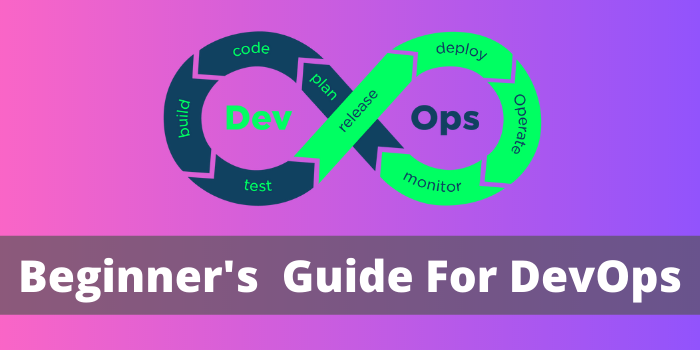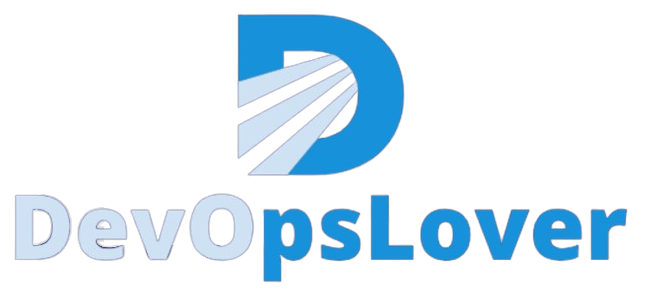The Ultimate Guide For Beginners –
What is DevOps?
What Is DevOps -It is the combination of two words, one is Development and other is Operations.
This allows a single team to handle the entire application lifecycle from development to testing deployment and operations.

Devops helps to reduce the disconnection between software developers, quality assurance engineers and system administrators.
DevOps promotes collaboration between development operations teams to rapidly deploy code into production in an automated and repeatable manner. Devops help organizations speed up to better deliver applications and services to their customers and compete more strongly in the marketplace. Devops has become one of the most valuable business topics for enterprises or organizations.
Devops represents a change in the IT service delivery through the adoption of agile practices in the context of a system-oriented approach.
Why DevOps ?
The operation and development team worked in complete isolation.
Design-build is followed by testing and deployment respectivelyThat’s why they consumed more time than actual build cycles.
Devops History
Devops means the cross department integration between development , the department creating the code and operations , the department using that code.
It’s a little more complicated than that . There are many stakeholders along the way here. The idea began in 2008 with a discussion between Patrick Debois and Andrew Clay Schaefer about the concept of agile infrastructure. However, the idea began to spread with the advent of the first DevopsDays event, held in Belgium in 2009. What began as a desire to bring more efficiency to software development has evolved into a feedback oriented system designed to modify every aspect of Devops is that Software crosses a traditional line by merging development with the environment in which it is developed
The birth of DevOps is not so surprising; It has a history of becoming more and more relevant to more and more people all the time.
What was once walled off in its own department within corporations and universities has now spread across the world and into everyone’s pocket . Devops takes the next logical step in this evolution by unifying or at least linking development and operations to create a spectrum of activity in which everyone can participate.
Read Also- Understanding Kubernetes
What is DevOps Architecture Feature ?
- Automation
- Collaboration
- Integration
- Configuration Management
1) Automation: Automation can reduce time consumption especially during the testing and deployment phase.
For contiguous delivery each code is defined through automated tests, cloud-based services and builds.
2) Collaboration: Development and operations teams collaborate together as a DevOps team which improves the cultural model as teams become more effective with their productivity which strengthens accountability and ownership.
3) Integration: Applications need to integrate with other components in the environment. The integration phase is where the existing code is integrated with new functionality and then testing takes place.
The frequency in the release and microservices lead to significant operational challenges.
To overcome such challenges , continuous integration and delivery are implemented to deliver in a quicker , safer and reliable manner.
4) Configuration Management: This ensures that the application only interacts with the environment in which it runs. The configuration files are created where the configuration external to the application is separated from the source code.
DevOps Advantages and Disadvantages:
Advantages:
- Devops is an excellent approach for quick development and deployment of applications.
- It responds faster to the market changes to improve business growth.
- It improves customer experience and satisfaction.
- Devops means collective responsibility which leads to better team engagement and productivity.
Disadvantages:
- Devops professional or expert’s developers are less available.
- Developing with Devops is so expensive.
- Adopting new Devops technology into the industries is hard to manage in a short time.
DevOps Architecture:
Build:
The cost of resource consumption without devops was evaluated based on pre-determined individual usage with fixed hardware allocation.
But with Devops , the usage of cloud ,sharing of resources comes into the picture and the build is dependent upon the user’s need which is a mechanism to control the usage of resources or capacity.
Code:
Many good practices like the widely used Git enable the use of code that ensures not only changes are tracked, is informed about the reason behind the change and if necessary reverting to the original code developed. Test: After testing the application will go into production. In case of manual testing, it takes more time to test and move the code to production. This can be reduced because automating the operation of the script will remove many manual steps.
Plan:
DevOps use agile methodology to plan the development and Operations team in sync ,it helps in organizing the work to plan accordingly so as to increase productivity.
Monitor:
It is helpful to track the system accurately so that the health of the applications can also be checked. The monitoring becomes easier with services where the log data may get monitored through many third-party tools like splunk , ELK , Grafana.
Deploy:
Many systems can support the scheduler for automated deployment.The cloud management platform enables users to gain accurate insights by deploying dashboards and viewing customizable scenario analytics on trends.
Operate:
DevOps changes the traditional approach of separate development and testing.The teams operate in a collaborative way where both the teams actively participate throughout the service lifecycle.
Release:
Deployment to an environment can be done by automation but when the deployment is made to the production environment , it is done by manual triggering.
Read Also – http://Understanding Jenkins
Devops LifeCycle
Development:
phase involves the planning and coding of the software.
The vision of the project is decided during the planning phase. And developers start developing the code for the application.
Integration:
This stage is the heart of the entire devops lifecycle. It is a software development practice in which the developers are required to commit changes to source code more frequently.
Testing:
This phase , where the developed software is continuously testing for bugs. For constant testing, automation testing tools such as Testing, Junit, Selenium etc are used.
Monitoring:
It is a stage that includes all the operational factors of the entire DevOps process where important information about the usage of the software is recorded and carefully processed.find out trends and identify problem areas.
Feedback:
The application development is consistently improved by analysing the results from the operations of the software.
Deployment
In this phase the code is deployed to the production server. Also, it is necessary to ensure that the code is used correctly on all servers.
Operation:
All devops operations are community based with full automation of the release process and allow the organization to consistently accelerate overall time to market.
Devops Principle
1) End to End responsibility:
Devops teams need to provide performance support until they become the end of life.
2) Continuous Improvement:
DevOps culture focuses on continuous improvement to reduce waste. This continuously gives impetus to the development of the proposed product or service.
3) Automate Everything:
Automation is an essential tenet of the DevOps process.
4) Custom Centric Action:
Devops team must be customer-centric for that they should continuously invest in products and services.
5) Monitor and test everything:
The Devops team needs to have a robust monitoring and testing process.
6) Work as one team:
In the Devops culture the role of the designers , developers, and testers are already defined.
They just need to work as a team.
What things you need to learn if you want to move your career into DevOps ?
If you want to get started with DevOps then you can start learning about the following things: Linux basic commands, UNIX system internals, Build and release deployment process, Git version control System , Learn about CI/CD .
Who can become a good DevOps Engineer ?
The one who has quality and understanding about above best practices and complete understanding about how code is deploying into production can become a good DevOps Engineer.
What is CI / CD :
You also needs to understand continuous integration , continuous deployment and continuous delivery before implementing Devops culture .
Continuous Integration Continuous integration is about automating the build and testing processes to ensure that the resulting software is in good condition, ideally every time a developer changes the code.CI helps development teams avoid “integration hell” where software works on individual developers’ machines, but it fails when all developers combine (or “integrate”) their code.
Continuous Delivery Continuous delivery goes a step further to automate software releases, which typically involves packaging software for deployment in a production-like environment. The goal of continuous delivery is to ensure that software is always ready for production, even if the team decides not to do so for business reasons.
Continuous Deployment is a process that automatically deploys the results of Continuous Delivery into the final production environment, usually every time a developer changes code (assuming all automated tests pass).
By adopting both continuous integration and continuous deployment, you not only reduce risks and catch bugs quickly, but also move towards working software faster.
With low-risk releases, you can quickly adapt to business requirements and user needs. This allows for greater collaboration between ops and delivery, fuelling real change in your organization, and turning your release process into a business advantage.
Devops Tool Set :

Jenkins
Jenkins is a devops tool for monitoring the execution of repeated tasks.
Jenkins is a software that allows continuous integration.
Docker:
Docker is a high end devops tool that allows building ship and run distributed application on multiple system.
SonarQube:
SonarQube is the leading tool to continuously inspect the code quality and security of code bases and guide development teams in code reviews.
Kubernetes :
Kubernetes is an open source system for automating the deployment, scaling, and management of containerized applications. Kubernetes mainly used for docker deployments.
Git:
Git is an open-source distributed version control system that is freely available for everyone .It is designed to handle small to large projects with speed and efficiency.
Puppet:
Puppet is the most widely used devops tool.This allows technology changes to be delivered and released quickly and frequently. It has features of versioning , automated testing and continuous delivery.
Ansible:
Ansible is a leading devops tool. Ansible is an open source IT engine that automates application deployment, cloud provisioning, intra service orchestration and other IT tools.
Nagios:
Nagios is one of the more useful tools for devops. It can determine errors and correct them with the help of network infrastructure servers and log monitoring systems.
A chef is a useful tool for achieving scale speed and consistency The chef is a cloud based system and open source technology.
Splunk:
Machine data is usable, accessible and valuable to everyone. It delivers operational intelligence to the devops team and helps companies to be more secure, productive and competitive.
ELK:
ELK3 tool is a combination of Elastic Search, Logstash and Kibana which is used for centralized logging purpose.
Anchore:
Anchore is an open source tool used for scanning docker os and non os packages security vulnerabilities.
Dependency Track:
Dependency Track is an open source tool which is used for scanning third party security vulnerabilities . Used for maven , npm build vulnerability data analysis and fixes.
JFrog Artifactory
It’s an artifactory to store build artifact’s and binaries with maintaining version.
Conclusion :
DevOps is all about removing bottlenecks, better delivery practices, automation, and is Agile at Organisation level. It is not a tool, it cannot be made in a day or a month. It is a roadmap or set of best practices that need to be followed
Add comment if this article helps you in understanding Devops.
Hope you like this blog….
Tag –
The Ultimate Guide For Beginners
- Logic Building Assignments – 2025 - October 15, 2025
- Create Your First Ansible Playbook: Step-by-Step Guide - September 29, 2025
- Ansible Beginner’s Guide – What is Ansible & Step-by-Step IT Automation - September 9, 2025

